Guitars and other Stringed Instruments of Friar Park Studios, Henley-on-Thames (F.P.S.H.O.T.)
- Solo Beatles Studios

- Feb 25, 2024
- 60 min read
Updated: Dec 3
The intention of this post is not to be a compensative list of guitars ever owned by George Harrison, rather the ones that I've been able to document were at Friar Park and were/could have been used at F.P.S.H.O.T. While I tried my best to be comprehensive, George owned dozens and dozens of guitars and other stringed instruments in the time that F.P.S.H.O.T. was active so this list is almost surely incomplete.
GUITARS & BASSES
Bartell Fretless Guitar
Serial Number A132. After seeing a Bartell Fretless guitar at a session at Western Studio on 3 August 1967, George had Neil Aspinall (Beatles Personal Assistant/Roadie) place an order for one immediately from Al Casey's Music Room in Hollywood. That same night Casey's wife Maxine delivered the guitar to Harrison at Blue Jay Way in the Hollywood Hills where he was staying.
The fretless guitar George received was purportedly the first prototype made by the fledgling Bartell guitar company out of Riverside California. My guess is that the original prototype was the only one Casey had available in his shop, so that's the one he decided to give to George. Neil Aspinall wrote about their trip and the guitar specifically in The Beatles Book no. 51, which you can see below. Interestingly, Aspinall writes that he ordered "a couple" for the Beatles including a bass. I've never seen any evidence to suggest that those additional guitars were ever actually delivered, I'd love to know why!
While there is no solid documentation, many experts speculate the Bartell (which George took to calling his "mad guitar") was used on The Beatles tracks "Helter Skelter" and "Happiness is a Warm Gun". John seemed to have been taken with the Bartell as well and even gave an interview on 6 June 1968 while holding and playing the guitar which he mentions to the interviewer. The guitar remained with George at Friar Park until 1984/1985 when he gave it to session guitarist Ray Russell. Apparently while working together, Russell adeptly played the guitar which George found somewhat difficult to play well, so he gave it to him.
The guitar was sold at auction on 13 October 2020 for a whopping £237,562.50. The listing can be seen here. One reason so much is known about the Bartell Fretless is because author Paul Brett wrote an entire book about the guitar and its saga in 2021 called Finding Fretless: The story of George Harrison's mad guitar. Check out the book's website here.

Danelectro (unknown model)
This photo from the guitar room in the late '80s/early '90s shows what looks to me to be a black on black Danelectro U1/U2. The guitar has the classic Danelectro U headstock shape and single cutaway U body. The U1 is the one pickup version and the U2 is the version, by the way. There was a U3 but I don't believe that there was an all black version.
What is throwing me off with this guitar is that it looks to have a vibrato arm which U1s and U2s never had as far as I can tell. In my research I haven't been able to find a similar model with a tremolo arm, so I'm a little stumped. Of course it could be a modification, or just a model I'm not aware of. If you have any information on this guitar, feel free to reach out at solobeatlesstudios@gmail.com

Danny Ferrington Rutles mini Guitar
On 23 June 2023 Eric Idle posted the below left photo of a Rutles guitar at F.P.S.H.O.T. with the caption "Danny Ferrington made this car guitar, which I gave to GH. He loved it." (source).
The below right photo was at the 1999 preview party for Eric Clapton's Crossroads Centre auction. I'm not sure if George donated the guitar to be auctioned but I haven't been able to find out for sure. It would seem odd for him to have the guitar there otherwise, but who knows.
I believe that Ferrington built several instruments for George and also did repair work for him on several instruments as well. In addition to Goerge, Ferrington has made instruments for Idle, Eric Clapton, Kurt Cobain, Johnny Cash, John Prine, and many others.
Left: Ferrington Rutles mini guitar at Friar Park - Photo: unknown (probably George) / Right: George with the Rutles guitar at the Crossroads Centre auction - Photo: Dave Benett/Getty Images
Dobro Model 32 Resonator Guitar
This photo of the guitar room at Friar Park shows George's Dobro Model 32 roundneck resonator guitar. George perhaps used this guitar most famously on the John Lennon song "Crippled Inside" which was recorded at John Lennon's Ascot Sound Studio. For more information on that, see my Ascot Sound Studio page.
The Model 32 is the descendent of Dobro's Model 27 and was made from the 1930s to 1941 when Dobro ceased operations due to material shortages and restrictions brought on by the United States entering WWII. The Dobro Model 32, like most Dobros, was of the single inverted-cone design, sometimes called a "spider bridge" and had a completely metal body. George retained the Model 32 for the rest of his life and as far as I can tell it remains at Friar Park.

Epiphone Casino E230TD
George's 1965 Epiphone Casino can be seen in various photos of the guitar room at F.P.S.H.O.T. John and George both bought sunburst Casinos with nickel hardware and gold knobs in 1966 after seeing the Casino that Paul had bought in 1964 and started using with The Beatles in 1965. While John's Casino had a standard trapeze tailpiece, George's had a Bigsby vibrato similar to Paul's. They both had the newer Epiphone headstock as opposed to the older Gibson style that Paul's had.
George put his Casino into service during the Beatles last tour in 1966. During The Beatles trip to India in early 1968 the singer/songwriter Donovan mentioned that he thought guitars sounded better without a heavy finish. When they returned to England, George and John both sanded their casinos down to the bare wood. In his superlative book, Beatles Gear, Andy Babiuk mentions that John's casino was professionally sanded down to the natural wood and sprayed with a very thin unpolished layer of varnish. No mention if George's was done in the same manor, but I think it's a good bet it was.
As John did, George replaced the stock Kluson tuners with Gold Rotomatics sometime in the spring of 1969. Some people say that they made this change when they had the guitars sanded down, but John's Casino clearly had the Klusons through the Get Back/Let It Be sessions.
Though George didn't use his Casino as extensively as John did, he did used it in the studio from 1966 all the way up to and including the Beatle's very last sessions on 4 January 1970. George kept the Casino for the rest of his life and as far as I can tell it remains at Friar Park.
Ernie Ball Music Man Silhouette
Photos from the guitar room in 1987 show a black Ernie Ball Music Man Silhouette with a maple fretboard. The Silhouette was first introduced in 1986, so this would be a very early version. In this interview with Ernie Ball, George's son Dhani mentions growing up learning how to play on the "Ernie Ball guitar".
I don't have much solid info about George's Silhouette, but I do have a theory where it may have come from. I think its possible that the Silhouette ended up in George's hands through legendary guitar tech Alan Rogan. In the same Ernie Ball interview with Dhani, he says that that there were always loads of Ernie Ball strings around the studio due to George's guitar tech whom he shared with Eric Clapton, Pete Townshend, and Angus Young. This tech is likely Rogan who was known to be a close friend of the Ernie Ball company. Of course its also possible that George went out and bought it, but given his penchant for vintage guitars, this somehow seems unlikely to me.

Fender Bass VI
In the very corner of a photo from the guitar room, we can see a Fender Bass VI in sunburst finish. I had never seen one with a bridge cover so I actually had to do some searching to find that they indeed originally shipped with a bridge cover, which almost everyone seemingly took off and immediately lost.
The Fender Bass VI has a Jaguar-style body and combines elements of a bass and a guitar. It features six strings like a guitar but tuned an octave lower like a bass. The 30" scale length somewhere between is in between a guitar and a bass (a Fender Jaguar is 24" and a P Bass is 34"). It was essentially designed for guitar players to be able to play bass parts, which is exactly how The Beatles put it to use when they first received one during the White Album sessions in 1968. George played the Bass VI on several Beatles tracks such as "Birthday" and "Honey Pie" and I think possibly "Maxwell's Silver Hammer" and probably others.
As far as my research shows, the current whereabouts of the Beatles Bass VI are unknown. Could the Bass VI at F.P.S.H.O.T. be THE Bass VI? In the below photo from F.P.S.H.O.T. the sunburst finish looks a lot more yellow than photos of the Beatle's Bass VI. That said, the F.P.S.H.O.T. photo is also pretty saturated and taken 20+ years after the last photos of the Beatles Bass VI, so I don't think it can be ruled out. Also like the F.P.S.H.O.T. Bass VI, the Beatle's Bass VI had its bridge cover on as well which few seemingly ever did. Could it have been with George at F.P.S.H.O.T. all this time? Maybe!
Below left: the Bass VI at F.P.S.H.O.T. Below right: John playing The Beatle's Bass VI.
Fender Electric XII
Several pictures show George and a Firemist Gold Fender Electric XII twelve-string at F.P.S.H.O.T. I'm not sure when exactly George got the XII. It's not in 1979 guitars picture, but it is in the late '80s photos, so presumably some time in that time period.
Inspired in no small part by George and his Rickenbacker chime, the Fender Electric XII was released by Fender in June 1965 who was looking to cash in on the booming folk-rock boom. The XII was the last guitar designed by Leo Fender himself before the company was sold to the CBS corporation. One of the unique features of the XII was the bridge with twelve individual saddles - one for each string - unlike most twelve string guitars at the time which used six saddles (two strings per saddle). This allowed the Fender XII to have more accurate intonation than almost any other twelve strings guitars of the time. The XII also featured two split single-coil pickups and a four-way rotary pickup selector. With the selector the player could select each pickup by itself, both pickups together, or both pickups together out of polarity.
Fender switched from dot to block inlays on the XII in mid 1966, and from a gold to black Fender logo in 1968. George's XII had block inlays and what looks to me like a gold decal meaning his would have been from late 1966 or 1967. Despite the the Electric XII's unique features, it never caught on and was discontinued by Fender in 1970. George used this guitar for "If I needed Someone" on the 1992 Japan tour.
Lots of great info on the Fender Electric XII can be found here.

Fender Precision Bass
In this photo taken by Carl Perkins guitarist Wes Henley we can see a Precision Bass in the guitar room at Friar Park. I believe this photo is from 1988 or thereabouts. The P-Bass has a sunburst finish, white pickguard, and Rosewood fretboard. Unfortunately the image is of pretty low resolution so its hard to tell much more detail.
If this P is vintage, it would be a pretty odd duck. From what I can tell in the '50s and '60s sunburst finish with white pickguard was never a standard combo. However, white pickguards were used for custom finishes and could conceivably be special ordered for a sunburst bass as well. You can find examples of early '60s sunburst P-basses with white (mint) pickguards that are said to be completely original. If vintage, I think this bass would probably be from between 1959 and 1968. Rosewood fretboards became standard starting in 1959, and it doesn't look to have the waterslide-style PRECISION logo that was added starting in 1968.
A strong possibility is that this is actually an '80s 1962 P-Bass reissue (PB62). In 1982 Fender reissued the 1962 P-Bass, and from the distance/resolution of this photo it would be nearly indistinguishable from its vintage counterpart. The big difference with the PB62, at least from a visual standpoint, is that a sunburst finish with white pickguard was a standard combo.
Squier also offered a P-Bass with the sunburst/white combo in the 80s, the PB331, that would also fit the specs of George's bass. George played a Squier 1957 reissue Stratocaster at the Prince's Trust Concert in 1987, so its not a leap to think that Squier could have got a few instruments to him at some point in the '80s.

Fender Stratocaster (sunburst, Darkhorse sticker)
Hanging on the wall in the 1987 guitar room photo we can see the sunburst Strat that George played heavily on his and Ravi Shankar's 1974 North American tour. Based on the 1-ply, 8 hole pickguard (pre 1960), maple fretboard (pre 1959), the two-tone sunburst finish (pre 1959), and white ABS plastic (post 1956), we can determine that this Strat was probably manufactured in 1957 or 1958.
On the pickguard is a Darkhorse Records sticker - which looks ripped but is actually just worn from strumming - and a small metallic star sticker. On the lower bout is a sticker of a saxophone player with flames emanating from the bell (Jim Horn? Bobby Keys?).
I strongly believe this Strat may be one of the six Strats purchased by Eric Clapton in November 1970 at Sho-Bud music store in Nashville, Tennessee. In the 1995 book The Story of the Fender Stratocaster George says “I don’t have a whole lot of Strats. I’ve got a sunburst one, one that Eric gave me quite a few years ago. There was one that was stripped to the wood that I gave to Spike Milligan..." For those that don't know; three of the Strats purchased by Clapton became his legendary "Blackie" guitar, one was given to Steve Winwood, one to Pete Townshend, and one to George. Even though this story has almost become mythology at this point, I believe that this Strat being the one Eric gave George from the Sho-Bud six tracks quite nicely.
Note: Spike Milligan showed a sunburst Strat (with no stickers) on this 1984 TV program that was given to him by George. That could not be this Strat as we can clearly see that George still had the Strat three years later in 1987, stickers still intact.

Detail of the sunburst Strat at the Omni Coliseum in Atlanta, GA on 28 November, 1974:

Fender Stratocaster (brown, Darkhorse sticker)
In the 1979 photo of George and his guitars in the guitar room at F.P.S.H.O.T. we can see a tiny sliver of second Strat with a Darkhorse sticker on the pickguard. I believe this was the brown Strat with maple fretboard that George used on his 1974 North American tour.
This guitar looks to have a pre-CBS headstock, 8 pickguard holes, and yellowed "Bakelite" plastic parts which would mean this is likely a very early Strat, from between 1954 and 1957. From 1954 to early to mid 1957 Stratocasters utilized "Bakelite" plastic (actually polystyrene) for knobs, pickup covers, pickup selector switch caps, and other plastic parts. It became apparent pretty quickly that this polystyrene was brittle and though it started as white, it yellowed quickly. By early 1957 they started phasing out the polystyrene and phasing in ABS thermoplastic which was more durable and resistant to fading. (Thanks to Sam Popkin for hipping me to dating Strats with Bakelite plastic.)
This guitar almost surely started out having a two-tone sunburst finish which was the standard finish for Stratocasters of that era. Even though Fender offered a handful of custom colors (of which brown was not one) for a 5% upcharge, non-sunburst Strats of this era are exceedingly rare.
So, the brown finish we see in the photos with George would have to be a refin. In some photos from the 1974 tour you can definitely see wood grain, so I think its probably some kind of dark stain rather than paint. Fender introduced the finish 'Walnut' (#522) in 1972 which looks very similar to the finish we see on George's Strat, so perhaps he saw a guitar in Walnut finish and decided he wanted that for this Strat.
The 1979 guitar collection pictures are the last images I've been able to find of this guitar. But, I've found some evidence that this Strat was possibly refinished black in the mid '80s. See below for more information on that.
Left: A sliver of the brown Strat is visible in the guitar room in 1979 - Photo: Brian Aris. Right: George playing the Strat on 12 November 1974 at the Forum in Inglewood, CA - Photo: Ed Finnell
Fender Stratocaster (black, white pickguard)
In the 1987 photos of the guitar room we can see a black Stratocaster with white pickguard and a maple fretboard. It looks to have a pre-CBS headstock with "ORIGINAL contour body" decal, 1-ply 8 hole pickguard, and yellowed "Bakelite" plastic parts which would make this Strat from between 1954 and 1957. I believe there is a very good chance that this guitar is the brown '50s Strat (see above) refinished in black and with the sticker removed from the pickguard.
In the mid 1980s, luthier Roger Giffin did work on several of George's guitars including a Strat from the '50s which he refinished matte black. "He [George's guitar tech Alan Rogan] also brought in a '50s Strat and George's original Rickenbacker 12 string. I refinished the Strat matte black (I've seen George playing that in a video)..." -Roger Griffin (source). I believe that would be the video for "When We Was Fab" filmed in December 1987.
While many might view refinishing a '50s Stratocaster as sacrilegious, if the guitar in question was in fact the brown Strat, I believe it had previously been refinished anyway. In that case, having the brown Strat refinished in black would make sense—it would actually be a return to a more classic Strat color. And while almost all of the guitars in the 1979 photos of George's guitar collection are still in the 1987 photos, the brown Strat is conspicuously missing. Of course, none of these are definitive proofs, but they all suggest that this refin theory is a definite possibility.


I think its worth noting that the above black Strat at Friar Park is not the Strat George was pictured with in 1970 (left). The 1970 black Strat clearly has a rosewood fretboard, a large CBS-era headstock, and "STRATOCASTER" logo on the headstock. This black Strat, by the way, was likely a rented.
Fender Stratocaster (McLaren F1)
This Stratocaster was a custom collaboration between Fender and McLaren Cars and was designed to match George's custom McLaren F1 sports car. George's F1, Chassis 025, was registered in January 1995 so I'm guessing this guitar was built in 1994 and he received it in January 1995. Some of the customizations include large black knobs, an "Om" logo on the headstock and custom backplate and plaque on the rear. The color is Dark Purple Pearl and the pickguard is dark carbon fiber, both of which matched the car.


The first time we see the McLaren Strat is the February 1995 sessions for The Beatle's songs "Real Love" and "Now And Then" at Paul's studio.
At F.P.S.H.OT.. in December of 1997 while overdubbing solos for Ringo Starr's "King of Broken Hearts" and "I'll Be Fine Anywhere" we can see the Strat still has three lace sensor pickups (as it did in February 1995).
In November of 2000 we can see George using the McLaren Strat on "My Sweet Lord (2000)", the white lace sensor pickups have been replaced with carbon fiber pickup covers that match the carbon fiber pickguard. My guess is that these carbon fiber pickup covers were what originally came on the guitar.
Here is the back of the guitar. The plaque says:
F1 McLaren
Chassis No. 25
McLaren Cars Limited
Surrey England
To the right of the text is a "Om" symbol which matches numerous "Om" found on and throughout the car. Below the plaque is a custom backplate that reads "GEORGE HARRISON".

When the McLaren Strat has been exhibited recently, it has more standard looking black Strat knobs, and carbon fiber pickup covers that match the pickguard.

I think its also worth noting that there was an amplifier that went along with this guitar that was disguised as luggage and fit into the boot of the car. At first I kind of dismissed that as something that was probably of little actual utility. Recently however, I saw documentation that George used the McLaren amp at Paul's studio in 1995 for "Now And Then". It seems logical that it would have been around with the Strat at F.P.S.H.O.T. as well.
I think there is a good possibility that, because the guitar was made by Fender, that the amp was as well. The control panel looks very much like a Pro Junior to me. The 15-watt Pro Junior was released in 1994 and featured a 10" speaker and just volume and tone controls. It would be the perfect amp to stuff into a suitcase.
I'd like to thank reader Adonai Garcia for giving me a ton of great info on this guitar. Before Adonai contacted me I knew very little about it. For more information on George's F1 (the car) see this link and this link.
Fender Stratocaster (Rocky)
Serial Number 83840. George's famous psychedelic Stratocaster, Rocky, can be seen in photos from F.P.S.H.O.T. from the very earliest days of the studio on. Rocky started as a 1961 Stratocaster in Sonic Blue with a date stamp on the neck of December 1961. Rocky was purchased by Beatles Roadie Mal Evans at the behest of George along with an identical Strat for John in February 1965.
The back of the headstock had a decal that read "Grimwoods - The music people - Maidstone and Whitstable". The music stores Mal normally shopped at for The Beatles were Sound City, Selmer, and Drum City, all in Central London. It seems unlikely Mal would have driven over an hour to Maidstone or farther to Whitstable. I think that it's more likely that the guitar had been sold at Grimwoods in the past and that Mal bought them in London.
Said George of the purchase of the Strats: "It was funny because all these American bands kept coming over to England saying, 'How did you get that guitar sound?' And the more I listened to it, the more I decided I didn't like the guitar sound I had. It was crap. A Gretsch guitar and a Vox amp, and I didn't like it....But anyway, I decided I'd get a Strat, and John decided he'd get one, too. So we sent our roadie, Mal Evans, said go and get us two Strats. And he came back with two of them, pale blue ones. Straight way we used them on the album we were making at the time, which was Rubber Soul [George misspoke or was mistaken, they were purchased during the Help sessions. -Ed] - I played it a lot on that album, [most noticeably] the solo on 'Nowhere Man' which John and I both played in unison."
The Strat got its famous Dayglo psychedelic paintjob in towards the end of the Sgt. Pepper's Lonely Hearts Club Band sessions in the summer of 1967 and was thus dubbed "Rocky". “Colorful clothes, colorful houses and cars… it was just logical to have a colored guitar. So I got some Day-Glo paint out of a tin and just painted [the Strat] with a brush. And it’s not so much a great paint job, but that’s the way it came out. There’s some…nail varnish on the top, green glittery stuff. And the guitar’s called Rocky.” -George Harrison
George used Rocky extensively throughout the rest of The Beatles' career and throughout his solo career, eventually setting it up for slide: "I'm so dumb, really. It takes me years to figure things out. But through Ry [Cooder] – I really like his slide – I realized that you jack the bridge up a bit and you put thicker-gauge strings on it, so it doesn't clatter around. So I have my psychedelic Strat set up like that now." -George Harrison (source)
George kept Rocky for the rest of his life and it remains at Friar Park today.

Fender Stratocaster (Concert For Bagledesh)
While there are no photos of it at F.P.S.H.O.T., I think that the sanded-down Stratocaster George played at the Concert For Bangladesh was likely at Friar Park when F.P.S.H.O.T. existed. According to George, he gave the Bangladesh Strat to Spike Milligan after jamming with him and Peter Sellers at Friar Park (source).
As I explained on the Ascot Sound Studios page, I believe there is a lot of good evidence to suggest that the Bangladesh Strat was the one George played on the sessions for John Lennon's Imagine, and that that Strat was John's. In 1965, John and George both received 1961 Sonic Blue Stratocasters. George's Strat famously got a psychedelic paint job around 1967 and has come to be known as "Rocky", but the whereabouts of John's have become somewhat of a mystery. There is some good evidence that the Imagine Strat is actually John's 1961 Sonic Blue Strat (which originally had a rosewood fretboard) with a replacement neck with maple fretboard from the late '50s.
From what I can tell, the combination of a maple neck and mint 3-ply pickguard with 11 screw holes make it unlikely (impossible?) that this was a stock model made by Fender. The most likely explanation is that the neck was replaced (though its also possible that the guitar was re-drilled and the 8 hole pickguard was replaced with an 11 hole). John's Strat is rumored to have had neck problems which is possibly why John can be seen playing a black 1964 Strat towards the end of 1965 even though he had just got the Sonic Blue Strat month before. In any case, the most direct evidence I can find for this being John's 1961 Strat is the description on this video on the official John Lennon YouTube page which contains the line "A bearded George Harrison is in front of you, to the right, playing electric slide on John's pale blue Fender Strat."
There is also conjecture that the Strat that George played a few months later on the Concert For Bangladesh on 1 August 1971 was the Sonic Blue Strat from Imagine sanded down to the white undercoat/bare wood. Though many say the sanded Bangladesh Strat was the (formerly) sunburst Strat given to George by Eric Clapton, there's some convincing evidence for the Imagine Strat theory. For starters, the Bangladesh Strat had the same maple fretboard/3-ply, 11 hole mint pickguard combo as the Imagine Strat. But the most convincing evidence I've seen offered is the distinctly darker screw visible between two silver screws on the pickguard, and a burn/dark spot on the 21st & 22nd frets by the high E string. Click on the below photos to enlarge.
Fender Stratocaster (Eric Clapton Stratocaster signature model)
In the below photos we can see a green Stratocaster which I believe to be an early Eric Clapton Stratocaster signature model. The color is "Candy Apple Green"-sometimes called "7-Up Green"-and the fretboard is maple. Equipboard identifies it as a 1987 which I believe if true would probably make this one of the rare "version 1" EC Strat models which were sort of preproduction models made before the final production "version 2" of the guitar became widely available in 1988.
Both "version 1" and "version 2" Eric Clapton Strats featured Gold Lace Sensor pickups, a TBX tone control, and an active MDX mid-range boost. On the version 1 guitars the mid-range boost was 21dB at 500Hz and could be switched on and off via a mini toggle switch between the tone knobs. On the version 2 the boost was increased to 25dB and the toggle switch was ditched in favor of the boost being controlled with the tone knob. Version 1's had 21 frets, but Clapton decided to go with 22 frets for the production version. Unfortunately this photos isn't of sufficient resolution to tell which version it was that George had.
There is lots of great info on the early Eric Clapton Signature Strats here.
Left: The green Strat in the guitar room - Photo: unknown / Right: with Lizzie Webb outside at Friar Park in the early '90s - Photo: via The Henley Standard
Fender Telecaster (sunburst, black pickguard)
A sunburst Telecaster with a bound body, black pickguard, and maple fretboard can be seen in photos of the guitar room in the late 80s or early 90s. Its hard to tell much detail from the photo and this is the only image I've ever seen of this particular guitar in George's collection.
George didn't seem to be very interested in Teles until later in life. Though he's frequently associated with his Rosewood Tele in many people's minds, he famously hated that guitar and only played it for a few weeks in 1969.
In 1987, he appeared in the video for "Got My Mind Set On You" with a white Tele, in 1991 and 1992 he played a Fritz Brothers Roy Buchanan Bluesmaster (Telecaster) on tour, which he was quite fond of, and in 1995 he played a green Hamburguitar Tele on "Real Love". Add the three Tele's George had at Friar Park and you have quite the collection.

Fender Telecaster (sunburst, white pickguard)
In this photo from I believe the late '80s or early '90s we can see another sunburst Telecaster with maple fretboard, this one with a white pickguard. Please excuse the image quality, this photo of a photo is the only copy I can find of this image. Unfortunately due to the quality it's difficult to make out much more detail.
I suppose that its possible this is the same Tele as above with a different pickguard, but to me the black part of the burst looks thinner and I think the body may not be bound. Furthermore, I don't get the impression that George was one to change out guitar parts for aesthetic reasons, at least not at this point in his life.

Fender Telecaster (blackguard)
In this photo from I believe the late '80s or early '90s we can see what looks like a blonde/butterscotch Telecaster with maple fretboard and black pickguard. Of course, these features could make this what is known as a 'blackguard' Telecaster.
Blackguard is the informal name given to the Telecasters made from 1950-1954. To this day original Blackguards are some of the most sought-after guitars on the planet. Generally speaking, blackguard's had ash bodies with a translucent blonde finish (that would yellow over time to become what we now call 'butterscotch'), maple fretboards, and black pickguards.
Adding to the confusion, the initial name for the two-pickup version was 'Broadcaster', but due to a copyright issue, Fender had to remove the 'Broadcaster' name. For a short period, the guitar was produced without a name, leading to it being referred to as 'Nocaster'. It was not until 1951 that the guitar was officially named 'Telecaster'. Additionally, there was a single-pickup version known as the 'Esquire'.
Another possibility is that this Tele is something like a American Vintage Reissue '52 Telecaster which Fender made from 1982 to 2012. From what I can tell, the Reissue '52 Tele was the first guitar Fender manufactured with a 'butterscotch blonde' finish to look like a faded translucent blonde telecaster from the 1950s.
Unfortunately, due to the poor quality of this image it's almost impossible to tell much detail about this guitar other than the basics. If we had a better image we could at least tell whether or not it was a Broadcaster/Nocaster/Telecaster or an Esquire.
It's also worth noting that George used a similar blonde/butterscotch Tele in the 1987 video for "Got My Mind Set On You". That guitar, however, featured a white pickguard, and since the video was shot in Los Angeles, I think it is likely that it was either rented or borrowed.

Gibson ES-5
A sunburst Gibson ES-5 can be seen in F.P.S.H.O.T. photos dating back to at least 1974. According to George's official social media the ES-5 is from 1956. George had this guitar dating back to at least 1968 when he can be seen playing it on Jackie Lomax sessions in 1968 in Los Angeles. Its most visible appearance is in the music video for George's song "Ding Dong, Ding Dong" in 1974.
I sometimes see this guitar incorrectly identified as a "Switchmaster", but it is in fact a non-Switchmaster ES-5. The ES-5 was first introduced by Gibson in 1949 and had three individual volume knobs, one for each of its three P90 pickups and a master tone knob located on the top bout. In 1955 Gibson updated the ES-5 with a pickup selector switch - hence the "Switchmaster" name. The guitar retained the design of one volume knob for each pickup but added a tone knob for each pickup as well. This website says only four non-Switchmaster ES-5's were shipped by Gibson in 1956. If true, that would make George's ES-5 very rare indeed.

Gibson ES-5 Switchmaster
In this image from the Living In The Material World documentary, and again in images from the guitar room in the 90s, we can see George playing a Gibson ES-5 Switchmaster with a natural finish. As mentioned above, the ES-5 Switchmaster was the version first introduced by Gibson in 1955 to replace the original ES-5 which had been manufactured since 1949.
Like the original ES-5, the Switchmaster featured three P90 pickups with 3 volume knobs, but added 3 individual tone knobs and a four-way pickup switch. The switch could select each individual pickup or all three together.

Gibson ES-225TN
On the wall in this 1999 photo of the guitar room we can see a Gibson ES-225T in natural finish. This is the only photo I've ever seen of this guitar at F.P.S.H.O.T., so its possible it was a later acquisition.
The ES-225T is notable for being the first thinline hollowbody guitar ever manufactured by Gibson. It was only made from 1955-1959 before being discontinued. George's ES-225T has a single P90 pickup, but from 1956 to to 1959 Gibson manufactured a dual P90 version as well.

Gibson ES-335
In this photo in the guitar room in 1987, we can see George playing a cherry red Gibson ES-335. I believe the the block inlays, stop tailpiece, and slightly pointed cutaways would mean that this ES-335 was from between 1962 and 1964. This guitar looks very similar to his good friend Eric Clapton's 1964 ES-335 on which George famously affixed a Hare Krishna stamp on the back of the headstock.
This is the only photo I've seen of George playing this ES-335, though he did briefly have a tobacco sunburst ES-345-TD in the '60s that he played in the "Daytripper" and "We Can Work It Out" videos as well as a few 1965 Beatles tour dates.

Gibson J-160E
Serial Number 73161. The J-160E is an acoustic-electric guitar which Gibson dubbed the “Electric Jumbo Model”.
Sorry for the poor image quality, this is the only photo I can find of the J-160E at F.P.S.H.O.T. where you can more or less see the entire guitar.

This guitar has quite the history. It was purchased on 10 September 1962 at Rushworth's Music House in Liverpool. Along with George, John bought an identical J-160E that day, serial number 73157. According to Gibson's records, both shipped from the Gibson Factory on 27 June 1962.
Soon after they bought the twin guitars, John and George switched them and 73161 became George's. Below left, we can see the original receipt for the J-160E on which you can clearly see John's name and the serial number 73161. It is unknown if they switched them knowingly or by mistake. Below right is George and John at Rushworth's on 10 September 1962. The guitar John is holding is 73161 which would soon become George's. 73157 was subsequently stolen from a Beatles show in December 1963 at the Finsbury Park Odeon in London.
In the early '60s, George appears to have experimented with the placement of the guitar's P-90 pickup. The pickup was first moved between the sound hole and bridge. Eight holes were drilled to accommodate this move - six holes were for the pickup's pole pieces and two for mounting screws. I can't find any photos of the guitar with the pickup in this placement, so I don't think it remained there long. The pickup was then moved to the lower side sound hole. Two holes were drilled for mounting and the pickup straddled the hole. The pickup was in this position by 1965 at the latest. As late as 1968 the pickup was still in this position. At some point between 1968 and 1987 when we see the guitar at F.P.S.H.O.T. the pickup was moved back to its original location just under the guitar's neck.
As far as I can tell, The J-160E remains at Friar Park to this day.
Gibson J-200
This guitar room photo, probably from the '80s or '90s, shows what I think could be George's sunburst Gibson J-200. According to Andy Babiuk in Beatles Gear, George acquired the guitar in America around 1968. George used it on The Beatles songs “For You Blue”, “Here Comes the Sun”, “While My Guitar Gently Weeps”, “Long, Long, Long”, and “Piggies”.

There has been a lot a conjecture that George gave the J-200 to Bob Dylan which was the guitar he posed with it on the cover of his 1969 album Nashville Skyline. We know that George visited Dylan in Woodstock New York in November of 1968 and that the Nashville Skyline photoshoot took place in early 1969. So it is certainly possible that George gifted Dylan the J-200 he used on the White Album at that time. We also know George used and was photographed with a sunburst J-200 in January 1969 during the Let It Be sessions and again in 1970 at Trident Studios. So based on that evidence, I think George either didn't give the J-200 he had in 1968 to Dylan, or he did and got a second J-200 around that same time.
Below: George at Trident Studios with a sunburst Gibson J-200. Some sources say these are from the All Things Must Pass sessions, but I actually think they are from The Radha Krsna Temple sessions in early 1970 as we can see Mukunda Goswami at the piano.
Gibson L-4C
In the guitar rack in this 1999 photo, we can see a Gibson L-4C in natural finish. The L-4C is an acoustic archtop guitar first introduced by Gibson in 1949 which they continued to manufacture until 1971.
I've never seen any other photos of the L-4C at F.P.S.H.O.T., but its not in the 1987 photos, so he probably acquired it after then.

Gibson Les Paul Standard "Lucy"
Serial number 7-8789. In pictures from the 70s on we can see George's famous 1957 Les Paul Standard, dubbed "Lucy".
Lucy was originally a goldtop that shipped from the Gibson factory on 19 December 1957. By the 60s the guitar was owned by John Sebastian of The Lovin' Spoonful who traded it to Rick Derringer of The McCoys to replay him for an amplifier Sebastian had blown. By '66 the guitar was already road worn so Derringer had the guitar refurbished and refinished in SG red at the Gibson factory in Kalamazoo Michigan. Apparently he still wasn't thrilled with the guitar and sold it to Dan Armstrong's guitar shop in New York City where it was purchased just days later by Eric Clapton.
Clapton apparently didn't play the guitar much and gave it to George in 1968. George dubbed it "Lucy" as a reference to famous redhead Lucille Ball. Lucy would see use on The Beatle's The White Album (including Clapton's solo on "While My Guitar Gently Weeps"), Let It Be, Abbey Road, and into George's solo career. Lucy was stolen from George's home in a robbery in 1973 but he was eventually able to get it back by trading a sunburst 1958 Les Paul and a Fender Precision bass - instruments he bought specifically to make the trade - to the man who bought it at a used guitar store, a fact that George was none to happy about.
George kept Lucy for the rest of his life and it remains at Friar Park.

Gibson Les Paul
In the very back of the 1979 guitar room pictures we can see a Gibson Les Paul. Its hard to tell much about it but it looks to have Grover tuners and to my eye looks to be sunburst. I can't find any other images of this guitar at F.P.S.H.O.T. or of George playing it at F.P.S.H.O.T. or anywhere else.
Below left: the 2nd Les Paul in the guitar room in 1979. Below right: the only picture I've ever been able to find of George playing a sunburst Les Paul is from Japan in 1991. Of course the Japan Les Paul could be completely unrelated, who knows!
Gibson Les Paul
In video footage from December of 1997 at F.P.S.H.O.T. while overdubbing solos for Ringo Starr's "King of Broken Hearts" and "I'll Be Fine Anywhere", we can see Dhani playing what looks to be a classic 1957-style goldtop Les Paul with P90 pickups and Kluson-style tuners. I can't find any other images of this guitar at F.P.S.H.O.T. or of George playing it at F.P.S.H.O.T. or anywhere else.

Gibson Les Paul Junior
Photos from Traveling Wilburys sessions and in the guitar room in the 80s we can see a double cutaway Gibson Les Paul Junior in Cherry finish. I'm not sure if this photo is from the 1988 sessions for Traveling Wilburys Vol. 1 or from the 1990 sessions for Traveling Wilburys Vol. 3.

Gibson Super 400 CES
George can be seen playing a sunburst Gibson Super 400 during the sessions for "All Those Years Ago" in 1980. It may even be in the 1973 guitar room photos in the back, but its hard to tell for sure. It looks like George's Super 400 has humbuckers. Humbuckers were added to the Super 400 in 1957, so George's would be a 1957 at the oldest.
In many ways, Gibson was trying to make the most lavish guitar they could with the Super 400. At 18 inches wide it was a big guitar, the largest Gibson made at the time. It featured all carved wood construction and had to be built by hand which made it quite expensive. It was originally released as an acoustic guitar in 1934, but Gibson experimented with adding electronics as early as 1939. Elvis Presley guitarist Scotty More famously played a sunburst Super 400 with humbuckers, so I imagine that may have inspired George to get one of his own.

Gretsch 6120 “Chet Atkins”
George can first be seen publicly with an orange Gretsch 6120 on the Blue Suede Shoes: A Rockabilly Session. Blue Suede Shoes was a televised concert was taped live on 21 October 1985 at Limehouse Studios in London and marked George's first public performance since 1974. Subsequently it can be see in photos from F.P.S.H.O.T., and he even included it in the 1987 article in Guitar Player where he shares photos of some of his favorite guitars.
“You know, I’ve always wanted one of them orange Gretsches with a big ‘G’ stamped on it. I finally got one - my wife got me the one I used on the Carl Perkins program for Christmas a couple of years ago - except it didn’t have a ‘G’ on it.” - George Harrison, Guitar Player, November 1987
Though The 6120 was the Chet Adkins model, I imagine that George fancied it based on that fact that it was the guitar played by Eddie Cochran who was an early guitar hero of George's. Although both the 6120 and 6121 look red in the below picture, they are in fact both orange.

Gretsch 6121 Chet Atkins
In the 1987 Guitar Player magazine article George talks about his Gretsch guitars, including a red guitar he calls the "newer" version of his Duo Jet. I originally thought this was a Jet Firebird, but now I'm pretty convinced that it is actually a solid-body 6121 Chet Atkins. Thanks to @les.schlepping on Instagram for pointing this out to me.
Its hard to find any solid info about the various versions of the 6121, but based on photo research I think I've been able to come up with a fairly accurate profile. When it was first released in 1955, the 6121 had "Neo-Classic" fret markers and many "western" adornments including tooled leather sides with brass buttons, a large branded G on the body, and a horseshoe inlay on the headstock. By 1957 the fret markers were switched to "Hump-Block" inlays and most of the western adornments had been removed. In 1959 Gretsch switched back to "Neo-Classic" fret markers. In 1961 they moved to a double cutaway version before discontinuing the guitar in 1963.
Based on the fact that George's 6121 is single cutaway with none of the "western" adornments and "Neo-Classic" fret markers, I believe that would make his 6121 from either 1959 or 1960.

Interestingly, in early 1963 George used a very similar Jet Firebird with The Beatles, though only for a very brief time. I've read that that Jet Firebird was borrowed, possibly from Rushworth's Music House in Liverpool while his Duo Jet was being repaired. This borrowed Jet Firebird was likely from the same era as George's 6121, but featured a black pickguard and no Bigsby.

Gretsch Duo Jet 6128
Serial Number 21179. In photos from the guitar room in the late 1980s we can see George's famous black 1957 Gretsch Duo Jet 6128 which he bought in 1961. 21179 was originally bought new for $200 at Manny's Music in New York City by Ivan Hayward, a Liverpool cab driver and former merchant seaman. Hayward had the Bigsby vibrato installed after he bough the guitar. According to Hayward: "We haggled for it and I knew I was never going to get £90."

"He gave me a bundle of pound notes which had been crumpled there was only £70 but the notes were really stacked high because they were so old. I had a hard time counting them." (source).
George wrote an IOU note for the remaining £20 balance on the back of the guitar's customs document which was kept by Hayward. Incidentally, George never paid the balance.
"Then we started making a bit of money, because I saved up 75 pounds, and I saw an ad in the paper in Liverpool, and there was a guy selling his guitar. I bought it; it was a Gretsch Duo Jet – which is now on my new album cover. It was a sailor who bought it in America and brought it back. It was like my first real American guitar, and I'll tell you, it was second-hand, but I polished that thing; I was so proud to own that. That was the reason I think when we went to the States to play the Ed Sullivan Show, Gretsch gave me a Gretsch that I used on the show." -George Harrison (source).
The Duo Jet was George's main guitar from 1961 through 1963. He played it on loads of Beatles shows in England and Germany, many of the early Beatles singles including "I Saw Her Standing There”, “Love Me Do”, “Twist and Shout”, and most of the rest of the Please Please Me album. George mostly retired the Duo Jet by mid 1963 after obtaining a few other Gretsch's and gave the guitar to friend Klaus Voormann.
In the mid 1980s feeling a touch of nostalgia, George asked Klaus if he still had the guitar and if he could have it back which Klaus obliged. “I’d asked him what happened to the guitar and whether I could have it back, because of its nostalgic value. So he returned it to me, and I had it fixed back in its original form with the original pickup and switches that had been missing from it since he owned it” said George (source).
Klaus had replaced the neck pickup and removed the pickup selector at some point so in 1985 or 1986 George gave the guitar to his Guitar Tech Alan Rogan to restore. Rogan had Roger Griffin do the work. "I had to rewire it because true to form with old Gretsch guitars, the original wiring was disintegrating" says Griffin (source). George famously posed with the newly restored Duo Jet on the cover of his 1987 album Cloud Nine.

Gretsch TW-100
In this photo from the guitar room we can see three Gretsch TW guitars. The TW series guitars were a collaboration between Gretsch and the Traveling Wilburys that were manufactured in Korea. Their purpose was to promote Traveling Wilburys Vol. I and the relaunch of Gretsch after the business came back under the ownership of the Gretsch family. Oddly enough, the TW Gretsch's look more like a Danelectro U1/U2 than anything Gretsch had made in the past. I've read that George had a hand in the guitars' design, but I haven't been able to confirm that.
The TW-100 is a short-scale mini guitar with one single coil pickup, a volume knob, and a three-saddle hardtail bridge. I believe that this was probably a prototype, but the final version of the TW-100 ended up essentially identical. My guess is that these three were sent to George so that he could offer feedback before the final production models were finalized.

Gretsch TW-300 (prototype)
I believe that this guitar is a prototype version of what was eventually released as the TW-300. It has a single humbucker, volume and tone knobs, and a tremolo-style bridge. On the production model the pickup was moved closer the the bridge.
George played a TW-300 in the music video for "Handle With Care", though not one of the ones pictured here. My guess is that these three were sent to George so that he could offer feedback before the final production models were finalized.

Gretsch TW-300 (prototype)
I believe that this guitar is a prototype version of what was eventually released as the TW-300. It has a single humbucker, volume and tone knobs, and a hardtale bridge. On the production model the pickup was moved closer the the bridge and I believe the hardtail bridge was abandoned for the tremolo-style version.
George played a TW-300 in the music video for "Handle With Care", though not one of the ones pictured here. My guess is that these three were sent to George so that he could offer feedback before the final production models were finalized.

Greven Resonator
In the 1987 Guitar Player magazine article, George shows a custom-built Greven Resonator guitar. Its hard to tell from photos if its a round or square neck guitar, but it seems George mostly owned roundnecks. George says that it was built circa 1974. I think that this would probably make this a pretty early Greven guitar.
There isn't a whole lot of information about John Greven online, but from what I can tell he worked for George Gruhn and then Gruhn Guitars in Nashville, Tennessee from the late '60's through the mid '70s so I think its possible Greven was still working at Gruhn when he built this guitar. George was probably familiar with Gruhn Guitars so I imagine that could be how he first encountered John Greven and Greven guitars.

Hagstrom H8
Zooming in on the guitar room photo, what looks to be a bass is visible behind the Zemaitis acoustic bass. I'm pretty sure this is a Hagstrom H8 8-string electric bass guitar. The headstock shape, tuner configuration, vertical logo, and string tree are all consistent with the H8. OI can't find any other photos of the H8 at Friar Park or photos of George playing it.
The H8 was the first eight string bass guitar as I can tell. The Swedish company introduced the H8 in 1967 and only made them for two years. The strings were setup in pairs and tuned an octave apart so the H8 would be played like a typical bass.

Hamer Prototype
In the guitar room photos from the late 80s/early 90s we can see a Hamer Prototype. Its hard to tell in this photo, but in other photos it looks like it may be in natural or dark sunburst finish. The Hamer seems like a kind of strange guitar for George to have, but I think there is a story which may explain its presence at F.P.S.H.O.T..
In September 1987 George was at the Village Recorder in Los Angles with Jeff Lynn to create an extended version of "Got My Mind Set On You". To extend the song it was decided some extra guitar work was needed. The studio had no guitar on hand so second engineer Jeffrey Gilbert fetched his Hamer Prototype for George to use. He recorded a new solo and then the guitar went back with Gilbert.
My speculation is that maybe there was something about that guitar that caught George's attention enough for him to get one for himself which would explain its presence at F.P.S.H.O.T. shortly after. Of course this could all be completely coincidental. Incidentally the Prototype George played at The Village Recorder was listed on Sotheby's in 2023.

Harptone "Lark" L12-NC
Serial Number 2004-27. We can see a 12-string Harptone L12-NC in several pictures and videos dating back as early as 1973 at F.P.S.H.O.T. According to Heritage Auctions, the guitar was acquired by George in 1968 and was used on All Things Must Pass and was played by Tom Evans on The Concert For Bangladesh. It can be seen in video from the Living In The Material World sessions in 1973 as well.
The L12-NC has a natural finish, spruce top, curly maple back and sides, and a maple neck. It has Harptone's standard black or tortoise shell nitrocellulose binding on the top and bottom of the body with mother of pearl dot inlays on the fretboard. George replaced the tuners with Schaller tuners at some point before giving it away.
In 1974, George produced and album for band Splinter at F.P.S.H.O.T. called The Place I Love. After the sessions George have the guitar to Splinter's Bobby Purvis who had played the L12-NC on the album. The guitar was sold by Heritage Auctions in 2004, you can view that listing here. The guitar is now in the Jim Irsay Collection.
Harptone "Zodiac" Z-6N
In several pictures and videos dating back as early as 1973 we can see a Harptone Z-6N dreadnaught acoustic at F.P.S.H.O.T. George can be seen playing the Z-6N in video footage from the Living In The Material World sessions in 1973.
The Z-6N has a natural finish, spruce top, and rosewood sides and back. It has Harptone's "deluxe artist" white nitrocellulose binding on the top and bottom of the body, neck, and headstock. It has Harptone's "deluxe artist" white nitrocellulose binding on top and bottom of body, neck, and head stock with mother of pearl block inlays on the fretboard. The Z-6N at F.P.S.H.O.T. has a post 1971 "dovetail" pickguard and at pre-1975 zero-fret meaning this guitar was made between 1972 and 1974.
Below left: the Z-6N in the guitar room in 1987. Below right: Carl Perkins playing the Z-6N in the control room at F.P.S.H.O.T. in 1989.
Note: the Z-6N was not the guitar played by George at the Concert For Bangladesh. That was a Harptone L6-NC. They can be told apart in two ways: the L6-NC has curly maple back and sides and a "coma" shaped pickguard while the Z-6N has rosewood sides and back and a "dovetail" shaped pickguard.
Hofner Model 126 (Club 50)
In the 1987 Guitar Player magazine article, George reveals that he has a Hofner Model 126 (Club 50) guitar in natural finish. George's very first electric guitar was a similar model, a Hofner Club 40, which he acquired in 1959 and played on many early Beatles concerts. He eventually gave the Club 40 away, but years later it would seem there was still a sentimental pull towards the Hofner Club-style guitar and George purchased this Model 127.
The Model 126 was very similar to George Club 40, but it had two single-coil pickups instead of one, individual volume and tone knobs for each pickup, and "treble" and "bass" tone switches.

José Ramírez Guitarra de Estudio classical guitar
In both the 1979 and 1987 guitar room photos we can see what I believe is George's José Ramírez Guitarra de Estudio classical guitar. This guitar was used on several Beatle's recordings including "And I Love Her." and "Til There Was You". According to the Ramirez website, the guitar was originally purchased by Klaus Voormann in the summer of 1963 in Madrid Spain and gifted to George early in 1964.
According to the Ramirez website, "The label identifies it as an “instrument for rondalla”, which at the time served to distinguish those guitars built by external Spanish factories, and which underwent a quality review process before being labelled and distributed (In this case it has the handwritten inscription in ink “Fl 1 or CL1”, which leads us to suspect that it was a prototype of a Ramirez Studio guitar, further supported by the fact that only two copies are known."
An extensive history of this specific guitar can be found on the Ramirez Guitar website.

Kramer/Ferrington KFS-1
When I first saw the below photo, I was kind perplexed and amused by '80s shredder-style guitar peaking out at the bottom. It didn't seem like something George would own. Then @red_stick_guitarandamp on Instagram hipped me to the Kramer/Danny Farrington collaboration and the penny dropped. Danny Ferrington was a luthier and friend of George's who made several ukulele's for him.
Ferrington teamed up with Kramer in the mid-1980s and produced several acoustic/electric guitar and bass models. The idea for these guitars seems to have been to create a guitar that felt and played like an electric guitar with the sound of an acoustic. The guitar in the photo from Friar Park looks like the KFS-1 model which was a Strat-style guitar with triple-ply binding. George's looks to have a "pointy" style headstock and diamond inlays on a rosewood fretboard.
From what I can gather the first batch of Kramer/Farrington guitars had the older "banana" style headstock and "sharks teeth" inlays on the fretboard. In the next few months the entire Kramer line switched to "pointy" style headstocks and diamond inlays. When Kramer went under in January 1991, Ferrington continued to produce these guitars for a few years under the "Ferrington" brand name. All of the "Ferrington" branded KFS-1's that I can find have black headstocks and sharks teeth inlays. So I believe George's pointy white headstock and diamond inlays would mean that his KFS-1 was Kramer branded and made between 1986 and January 1981.

National Duolian
A "12-fret" National Duolian metal-body resonator guitar can be seen in both the 1979 and 1987 guitar room photos. Though the Duolian was National's most affordable guitar in the 1930s, they became highly collectable over time. They were manufactured between 1930 and 1939 and featured a steel body, wood neck, and a single cone resonator. From what I can tell, National switched to "14 fret" in 1934, so that would make George's a 1930-1933 model.

National Studio 66
On the wall in the guitar room in 1987 we can see a white National Studio 66 electric guitar. The Studio 66 was produced from 1961 to 1963 by the Valco company. The guitar is made out of what National called "Res-o-glas" which was their trade name for fiberglass. The Studio 66 had a single pickup with volume and tone knobs, a trapeze tailpiece, maple neck, rosewood fretboard, and Kluson tuners.

Ovation 1619-4 Custom Legend
In the guitar room in the late 1980s we can see an Ovation 1619 Custom Legend guitar in natural finish (which makes it a 1619-4). It's well known that Paul McCartney and John Lennon both played Ovation guitars in the '70s and now it would seem we have proof that George played them too.
The 1619-4 featured a Sitka Spruce top, Ovation's trademark fiberglass body, a walnut bridge, Schaller tuners, piezo pickups with build-in FET preamp, and many adornments including abaloid purfling, 30 abalone inlays, ivory grained binding of the fretboard.

Ovation 1658-4 Custom Legend 12 string
In the guitar room in the late 1980s we can see an Ovation 1658 Custom Legend 12-string guitar in natural finish (which makes it a 1658-4).
The 1658 had similar features to the 1619 six string with a Sitka Spruce top, Ovation's trademark fiberglass body, a walnut bridge, Schaller tuners on a slotted headstock, piezo pickups with build-in FET preamp, and adornments including abaloid purfling, 26 abalone inlays, ivory grained binding of the fretboard.

Rickenbacker 360/12
Serial Number CM107. By my count, George gave away or lost (or had stolen) more than half of the guitars he played with The Beatles. One that remained in his collection was his Rickenbacker 360/12 in Fireglo finish. CM107 was a prototype made by Rickenbacker in December 1963 and was just the second Rickenbacker 12-string ever made.
George was gifted CM107 by Rickenbacker president F.C. Hall on 8 February 1964 in New York city while The Beatles were in town to film their first appearance on the Ed Sullivan Show. It was first played by John Lennon at the Savoy Hotel where Hall met with the band to show them some instruments. John suggested that George might like the guitar and so it was taken to Plaza Hotel where George was sick with strep throat. There are actually photos of George playing it for the first time.

"Yeah, I got number two. This friend of mine in England who takes care of guitars, Alan Rogan, just found out that the Rickenbacker 12-string of mine is the second one they made. The first one they gave to some woman, and the second one is the one I got. I got another one from them with the rounded cut-aways, but I'm glad to say that the one that went missing – I got a lot of stuff stolen or lost – wasn't that original one. That guitar is really good. I love the sound of it and the brilliant way where the machine heads fit so that even when you're drunk you can still know what string you're tuning." -George Harrison (source)
When George returned to England, he put CM107 to use immediately on recording sessions where it can be heard on songs like: "A Hard Day´s Night", "Eight Days A Week", "Ticket To Ride", and about a dozen more. George semi retired CM107 after receiving another 360/12 in the summer of 1965. He resurrected CM107 at F.P.S.H.O.T. for the Cloud Nine track "Fish On The Sand". The guitar remains at Friar Park to this day.

Rickenbacker 4001/4003 Bass
On the wall in the guitar room in what looks like the '80s or '90s, we can see what looks to be a Rickenbacker 4001 or 4003 bass in mapleglo finish. The 4003 was essentially a functionally upgraded 4001 with only minimal cosmetic changes so its impossible to tell which this was without more detail.
Of course, Paul McCartney famously played a Rickenbacker 4001S LH with The Beatles from 1965 onward and made the model world famous.

Rosetti Triumph
A Rosetti Triumph can be seen at Friar Park at least as far back back as the 1979 guitar photo collection and in guitar room photos in the '80s and '90s. I haven't yet found any pictures of George playing this guitar or any mention of it in any writings, but he seemingly liked it enough for it to stick around. George's first guitar was a Rosetti 276 acoustic guitar, so perhaps he had a soft spot for the brand.
Unlike the cheap 276 he had as a child, the Triumph was a much more substantial guitar. It was manufactured by Shergold Guitars and re-badged for Rosetti, a British musical instrument distributor. The Triumph was a Les Paul-style guitar with a bolt-on neck, volume and tone knobs, a 3-position pickup selector as well as a 3-position tone switch. The two "Shergold" pickups were designed by legendary designer Bill Lawrence and were actually used by several different brands. Though the photo below is black and white, the Triumph was mostly yellow with a slight red burst at the edges. I can't find exact information on the exact years the Triumph was manufactured, but it was likely built in the mid to late '60s.
Thanks to Alex Williams on Facebook for the tip on the make and model.

Squier Series '57 Vintage Stratocaster (dark, white pickguard)
In this photo from the guitar room in 1987 we can see a third Strat on the wall. It's very hard to tell anything about it, but I believe that it may very well be the tobacco burst "JV" Squier Strat with maple fretboard that George played at the Prince's Trust Concert that same year.
At first blush, it may seem strange for a vintage guitar aficionado and collector to be playing a Squier, but it's important to consider the history of the so-called JV Strat. JV stood for "Japanese Vintage" (the serial numbers began with "JV") and they were the first Strats produced in Japan, starting in 1982. They were one of Fender's first attempts to again manufacture Strats to pre-CBS specs and were based on 1957 and 1962 models. From what I can tell, the 1957 models all had maple fretboards and the 1962 models all had rosewood fretboards, meaning George's was a 1957 model.
The JV Strats were originally only intended for the Japanese market but were considered so good, and vintage-style guitars were so desirable, that they began exporting them to the UK. So its likely with his love of vintage guitars that George acquired this JV Strat.
Lots of great info on the JV Strats can be found here.

Steinegger Ike Everly Standard
In this control room photo of Jeff Lynn we can see George's Steinegger Ike Everly Standard acoustic guitar with its distinctive star inlays. According to Robert Steinegger, George's 1984 Ike Everly Standard was the fourth one made and was a gift from Phil Everly to George.
The original version of this guitar was the Gibson Everly Brothers Flattop, a custom J-185 style guitar that was manufactured by Gibson from 1962 to 1972. Only 488 were ever made. In 1981 Phil Everly began the process of creating a new version of Everly Brothers Flattop with luthier Robert Steinegger. The first Ike Everly Standard was delivered to Phil in 1982, followed by three more in 1984. It was the last of that second batch that was gifted to George in 1984. Incidentally Paul McCartney owned a Gibson Everly Brothers Flattop and would receive Steinegger Ike Everly Standard #23 in the '90s.
There is a lot of great technical information on the Steinegger Ike Everly Standard here.

Teisco TG-64
I believe this guitar to be some variation of a Teisco TG-64. In the below photo you can clearly see the TG-64's distinctive "monkey grip" on the lower bout of the guitar. Its hard to tell from this photo, but in other photos it looks to have the distinctive Teisco "metallic brown" finish. Teisco also made a "Bass VI" version called the TB-64, but the scale length of George's looks to be similar to the other guitars in the photo rather than the TB-64's 30" scale length.
I think this guitar was was modified in several ways. Most remarkably, the neck seems to have been replaced with what looks like a Fender Stratocaster-style neck. It's not visible in this photo, but between the two knobs the guitar has three toggle switches. My guess is that the original rocker switches had gone bad at some point and the three toggle switches were added to replace the original rockers.

Zemaitis Lotus Jumbo 6-string
In this photo from the guitar room in 1979, George is playing a Zemaitis Lotus Jumbo acoustic guitar which was built that same year. Although luthier Tony Zemantis probably became most famous for the electric guitars he eventually made, he started with acoustic guitars in the 1960s. As you see as you go down the list George was obviously a big fan of Zemaitis. I've counted at least 9 of his guitars at F.P.S.H.O.T., and George was known to have commissioned several as gifts.
The guitar has a spruce top, mahogany back and sides with a natural finish and black binding, and an ebony fretboard. The distinctive smile-shaped bridge is made from mahogany. The inlays are mother of pearl and frets three, seven, and twelve are the "om" symbol rather than dots. From what I can tell, Zemaitis custom built guitars of this vintage didn't necessarily have standard model names. We know that this guitar was called a "Lotus" based on the 2019 Met exhibit (see link below).
George played this guitar on his 1974 tour and it can be seen in many photos photos from recording sessions at F.P.S.H.O.T. The guitar is still owned by the Harrison estate and it remains at Friar Park. In 2019 the guitar was lent to the The Metropolitan Museum of Art for their "Play It Loud: Instruments of Rock & Roll" exhibit. Information from the exhibit can been seen here.

Zemaitis Jumbo 6-string
In this photo, we can see a second Zemaitis jumbo six string acoustic guitar. The construction looks similar to the Lotus Jumbo, but it has some noticeable cosmetic differences. There is a much more conventional sound hole rosette when compared to the very distinct lotus flower design on the Lotus Jumbo and it has a Yin Yang on the bottom bout. I'm not sure if it's actually part of the guitar or a sticker/decal. The fretboard inlays are basic dots, with a three dot design on the 12th fret.
This guitar's more basic appearance makes me think this guitar may pre-dates the Lotus Jumbo, but that is conjecture. George played this guitar in the music video for "Blow Away" in 1978. Note: from what I can tell, Zemaitis custom built guitars of this vintage didn't necessarily have standard model names, so we can't be sure if he gave this guitar a model name or not.
Zemaitis 6-string (miniature/travel 1)
In the 1979 guitar room photo we can see a miniature sized Zemaitis guitar. To me this guitar looks essentially identical to his Jumbo Lotus, just shrunken in size. It shares the same lotus rosette, "om" inlays on frets three, seven, and twelve, and smile-shaped bridge. George had this guitar custom made by Zemaitis so he could fit it in the overhead compartment of a plane. Because this guitar shares the same motif as the Lotus Jumbo, and Lotus 12-string, I think its a good bet this guitar was called "Miniature Lotus", "Travel Lotus", or something similar.
George was fond enough of this guitar to include it in the November 1987 Guitar Player article where he described just ten of his guitars. Of the mini Zemaitis he said: "When you're going on holiday, they always want you to put the guitar in the hold on the plane. So I wanted one small enough to fit in the rack, and I asked Zemaitis to make me one. He had to make the jigs specifically. The only other person I know who spotted the jig and got one made is Dave Gilmour."
Zemaitis 6-string (miniature/travel 2)
In this photo from the late '80s/early 90's a second miniature Zemaitis can be seen on the wall in the guitar room. It looks to be slightly larger than the other mini Zemaitis, though it may be the angle of the photo that makes it look larger. This guitar looks similar to the other mini, except that it doesn't seem to have the "om" inlays and the rosette looks to be more like sun rays than lotus flowers.
Note: from what I can tell, Zemaitis custom built guitars of this vintage didn't necessarily have standard model names, so we can't be sure if he gave this guitar a model name or not.

Zemaitis Lotus 12-string
In the guitar room in 1979 we can see George's Zemaitis Lotus 12-string guitar. According to the now defunct George Harrison Guitar Collection iOS app, George bought this guitar after playing Eric Clapton's 1969 Zemaitis 12-string nicknamed "Ivan The Terrible". If that's true, this may be the first Zemaitis George owned.
The twelve string looks essentially identical to the six string Lotus jumbo with the same body shape, "om" inlays on the third, seventh, and twelfth frets, and lotus flower rosette. The bridge looks to be smile-shaped, but less pronounced than the six string and larger probably to accommodate the twelve strings.
Zemaitis Superior Plus 12-string
In the November 1987 Guitar Player article George showed a dark 12 string Zemaitis. Based on the interior label, this guitar was built in 1985. I found a seemingly identical guitar online which was called a "Superior Plus". It has a heart-shaped sound hole, and heart inlays on the headstock, the fretboard, the bridge, the body and as the rosette. The other Superior Plus I found online has a mahogany body, and ebony bridge and fretboard, so I think it's very likely that George's was the same or very similar.
In 1989, fellow Wilbuy Tom Petty borrowed this guitar and played it on the BBC programme The Late Show. Petty performed the song "Yer So Bad".

After receiving the Superior Plus, George sent this thank you note to Tony Zemaitis and his wife Ann:
Zemaitis Thames Valley Special
In the mid 1980s George commissioned five custom guitars from Zemaitis that were christened "Thames Valley Special". #1 went to George, #2 to Alvin Lee, #3 to Carl Perkins, #4 to Dave Edmunds, and #5 to Joe Brown and they were delivered in 1986. Lee, Edmunds, and Brown were all neighbors to George at one point. The Thames Valley Specials had spruce tops, Indian rosewood back and sides, and ebony fretboards. There are heart inlays for fret markers and and unlike the other four, George's has heart inlays on the bridge. The soundhole decoration was unique to this model and was never to be repeated by Zemaitis.
Below right we can see a certificate that was included with each of the Thames Valley Special. This copy hung on the wall at Tony Zemaitis's workshop. Also on the wall at Zemaitis's workshop was a letter from George regarding the guitars during the design process. The letter “Tony, In a rush to get this to you – It’s a guess at a deposit on the Thames Valley Specials – and we’ll sort it out when I see you on the designs. At least you can go get the timber (if it is still available?). Will call mid week – till then all the best George. P.S. Deluxe Customs ??? Sounds good!! Lucky boys!”
Below is a young Dhani Harrison, Joe Brown, Alvin Lee, George and all five Thames Valley Specials at Friar Park in 1986. This is presumably right after they were finished and before Carl Perkins' was sent to America.

Zemaitis 12-string
In this photo of the guitar room in 1979 we can see a twelve string Zemaitis acoustic guitar.
It has a circular sound hole, dark rosette, and coma shaped pickguard. From what I can tell, Zemaitis guitars from the early to mid '60s seem to be slightly more conventional looking than the guitars he started building in the late '60s and '70s, so my guess is that this is possibly one of those earlier guitars.
It has the distinctive scroll shape bridge and headstock design and metal truss rod cover of many of his later guitars, but a more conventional rosette around a circular sound hole, pickguard, and fretboard inlays compared to his later guitars. Note: from what I can tell, Zemaitis custom built guitars of this vintage didn't necessarily have standard model names, so we can't be sure if he gave this guitar a model name or not.

Zemaitis Acoustic Bass
A Zemaitis acoustic bass can be seen in the guitar room photo from 1979. It has a sunray rosette around a circular sound hole, dot inlays, and a classic Zemaitis headstock design. Interestingly it has a floating wooden bridge as opposed to a bridge and saddle system like most acoustic bass guitars. Note: from what I can tell, Zemaitis custom built guitars of this vintage didn't necessarily have standard model names, so we can't be sure if he gave this guitar a model name or not.

Unidentified Guitars
Here are the guitars that I can't positively identify. If you know what any of them are for sure, please email me at solobeatlesstudios@gmail.com. Thanks!
Unidentified Acoustic Guitar
There is a "gypsy-jazz" style acoustic guitar in this photo from the live room in the '90s that I haven't been able to identify. The resolution is just too poor to make out any kind of detail. In 1994 George befriended gypsy-jazz guitarist Robin Nolan who went on to perform at parties at Friar Park several times before George's death. I wonder if this guitar had any association with Nolan.

Unidentified Electric Guitar
There is a guitar In the late '80s/early '90s guitar room photo that I haven't been able to identify. The guitar is a telecaster-style guitar with what looks to be a camouflage paintjob and I think a P90 pickup.

Unidentified Electric Guitar
I recently noticed what looks like a green Telecaster-style guitar with maple fretboard in this photo of the control room circa the 1990s. Its hard to tell much else about it unfortunately.

---------------------------------------------------------------------------------------------------------------------------
Other Stringed Instruments
Balalaika (unknown make/model)
In 1999, Elvis's original guitarist and drummer, Scotty Moore, and D. J. Fontana, visited Friar Park with their manager Dan Griffin. In a piece Griffin wrote about that day there is an anecdote about George having a Balalaika in the guitar room: "I was taking pictures and film with George’s camera when he broke out a Balalaika, a Russian guitar, and proceeded to play and sing “Trying To Get To You,” my favorite Elvis song."
I haven't been able to find it in a photo yet, but given George's vast collection of stringed instruments at Friar Park him having a Balalaika seems completely unsurprising to me.

Coral Electric Sitar
In several pictures from the guitar room and also the 1987 Guitar Player magazine article we see that George has a Coral Electric Sitar. According to George it may be the first one ever produced which would make it from 1967. George says that Spencer Davis borrowed it right after he got it and didn't return it for two years. By the time Davis returned it, George says "everybody had used one" so he never actually used it on a recording.
The Electric Sitar was a collaboration between guitarist Vinnie Bell and Danelectro and was released in 1967 under their Coral brand name. Its development was almost certainly in response to new interest in Indian music after George started incorporating Indian instrumentation into Beatles recordings in 1966. The Coral Electric Sitar was a standard six string guitar with an additional thirteen "sympathetic strings" to mimic the sympathetic drone of a Sitar. The guitar strings were fitted over what they called a "buzz bridge" which gave the guitar its distinctive sitar-like sound.

Dobro Lap Steel
A squareneck Dobro Lap Steel can be seen in photos of the guitar room in 1979 and 1987. Several variations of this lap steel were produced under both the Dobro and National brand names starting in 1935 (and following the Dobro/National merger in 1934). Some advertising refers to these lap steels as "Hawaiian Guitars".
The body is cast aluminum alloy with black panted sections and the fretboard is made from rosewood and features pearl dot inlays. It has a blade-style single coil pickup, and George's looks to have two knobs, volume and tone (some versions only had volume). George's has 19 frets which were only produced in 1935 and 1936. From mid-1936 on they switched to a 26 fret version.

Dobro Resonator Ukulele
In this photo from the guitar room George is holding a Dobro resonator ukulele in his left hand. Of course George was a huge ukulele and resonator enthusiast so I imagine a resonator ukulele must have really delighted him. Mark Makin, an expert in National and Dobro instruments who worked on this ukulele in 1994, informed me that it dates from the mid-1930s.
George's Resonator Uke was most likely made in the 1930s. The resonator guitar and then the resonator ukulele was first developed John Dopyera at National in the 1920s. In 1928 Dopryera and his brothers started Dobro and continued manufacturing resonator instruments like the Ukulele with wood bodies. When the United States entered World War II in 1941 production at Dobro and National ended so the metal could be used for the War effort.

Gibson Master F5 mandolin
I'm no mandolin expert, but this looks like a Gibson F5 to me. George owned several mandolins and played one on the Splinter song "China Light" from the album The Place I Love (which he produced), and on his own song "Mystical One" from the album Gone Troppo, both of which were recorded at F.P.S.H.O.T.
The F5 is almost inarguably the most famous mandolin model of all time having been popularized by the "Father of Bluegrass" Bill Monroe who played a 1923 F5. The F5 was designed under the Loyd Loar and first released by Gibson in 1922 as part of their "Master Model" series of instruments which also included the H-5 mandola, the K-5 mandocello, and the L-5 guitar. The roughly 250 F5's made under Loar's tutelage (and signed by him) from 1922 to 1924 are widely considered the greatest mandolins ever made and are highly desirable and collectable. I don't know if it's possible to tell from this photo if George's is a Loar F5, but he certainly would have had the means and influence to obtain one.

Kamaka Ukulele (unknown model)
In footage shot at Friar Park on 23 June 1994 for The Beatles Anthology, George is constantly seen with a Kamaka ukulele in his hand. Kamaka confirms that this was one of their ukes on their website. George and Paul actually play several songs on Ukes including "Baby What You Want Me To Do", "Dehradun", and "Ain't She Sweet".
George was known to be very fond of Kamakas and legend has it that when he was in Hawaii he would buy every Kamaka in stock at music stores like Bounty Music in Maui. Paul Weinstein, owner of Bounty Music, confirms in this article that George visited that store as many as a dozen times over the years.

National Style 1 Resonator Mandolin
This uniquely shaped instrument hanging on the wall of the guitar room in the late '80s/early '90s is a National Style 1 Resonator Mandolin. I had originally thought this was a tricone mandolin, but National expert Mark Makin tells me that he thinks it looks like a "standard Style 1, single cone, nickel plated mandolin."
George was clearly fond of all kinds of resonator style instruments, so him having resonator mandolin makes a lot of sense. National first released the Resonator Mandolin in the early 1930s and they continued to manufacture it until 1941. National was obviously most famous for their resonator guitars, but they also made resonator mandolins, tenor guitars, and ukuleles.

National Resonator Ukulele
In the below photo from the guitar room, George is holding a Dobro resonator ukulele in his left hand. I received some great details about this ukulele from Mark Makin, an expert in the field of National and Dobro instruments. He told me that this Resonator Uke dates back to the mid-1930s and that "It originally was painted in a yellow brown sunburst but has subsequently been stripped and nickel plated. The bright National logo on the headstock is a replacement."
George brought four ukuleles, including this one, to Makin for repairs in 1994. Makin continued "The little National in George's right hand needed some restoration as it had 'suffered' some damage and dents from his friend Jim Capaldi using it as a drum in an impromptu 'jam session' at Friar Park!!" What a great story!
The resonator guitar and then the resonator ukulele was first developed John Dopyera at National in the 1920s who later left and formed the Dobro company in 1928 with his brothers. In 1934 the Dopyera family regained control over National and formed the National-Dobro Corporation and manufactured both brands under one roof. Production of all National and Dobro instruments ceased when the United States entered World War II in 1941.

Rikhi Ram Sitar
A sitar can be seen in this photo from the guitar room In the late 1980s. I believe that this is the Rikihi Ram sitar George bought when The Beatles briefly visited India in 1966. “I bought a sitar. I had a guy bring them over – again, we couldn’t really get out easily. I bought a sitar off a man called Rikhi Ram, whose shop is still there in Delhi to this day." -George Harrison in The Beatles Anthology.
The Beatles visited Rikhi Ram & Sons store in the Connaught Place district of New Delhi in the afternoon of 7 July 1966. They were quickly swarmed with fans and retreated to The Oberoi, the hotel they were staying at. Rikhi Ram owner Bishan Dass Sharma arranged for a truck-full of instruments to be deliver to the hotel where he personally demonstrated them for The Beatles.

George's sitar was in the Pandit Ravi Shankar style. Speaking of George's Sitar, current Rikhi Ram owner Ajay Sharma says “This sitar uses cedar wood brought in from the Himalayas. The wood is seasoned for seven-eight years before one carves out a sitar from it. After that, the bridges, nuts, frets are added, and the inlay work is done.”
“It was the most expensive sitar in the store. It would have cost ₹700 to ₹1,000 at the time,”
(source).
In 2016 while on loan to the Victoria & Albert Museum, the Rikhi Ram sitar was damaged after being involved in an "unfortunate accident". According to a spokesperson for the the museum “Following conservation assessment, one of the sitar’s gourds was fully repaired in consultation with leading experts, and no permanent damage was sustained." I imagine it won't be leaving Friar Park again any time soon.

---------------------------------------------------------------------------------------------------------------------------
Unidentified Stringed Instruments
Here are the stringed instruments that I can't positively identify. If you know what any of them are for sure, please email me at solobeatlesstudios@gmail.com. Thanks!
Autoharp (unknown make/model)
This photo, which I'm guessing is from the late 1970s, shows an Autoharp of unknown make and model on the timpani at the live room of F.P.S.H.O.T. George is credit with playing autoharp on several releases recorded at F.P.S.H.O.T. including his 1987 album Cloud Nine, as well as Ravi Shankar's Shankar Family & Friends, Tana Mana, and Chants of India.

Banjo Ukulele (Banjolele) (unknown make/model)
The below photo shows George with a Banjolele at Friar Park. George's borderline obsession with the ukulele extended to the bajolele as well. George was a huge admirer of musician/comedian/actor George Formby whose trademark was the ukulele and banjolele. In fact it was probably Formby who inspired his exploding interest in the ukulele in the '80s.
Its hard to make out much detail in the photo, but we know George purchased several of Formby's instruments including this gold-plated Dallas 'E' banjolele and this 1928 Gibson UB3 banjolele. Its possible that this is one of those though I imagine - like ukuleles - George probably owned many banjoleles as well.

Dilruba (unknown make/model)
Photos from the Traveling Wilburys sessions at F.P.S.H.O.T. show George playing a Dilruba in the control room. I have been unable to find any information about the specific make or model of this particular Dilruba. There's no evidence that it made it on to either Traveling Wilburys record, but George is credited with playing Sitar on Vol. 3.
The Dilruba is a traditional Indian musical instrument. It is a stringed instrument similar to the sitar but with a smaller body and is played differently. It has sympathetic strings that resonate with the main strings and a bow used to produce the sound. The Dilruba is known for its haunting tone, often used in classical Indian music and Sufi devotional music.

Mandolin A style (unknown make/model)
The 1979 guitar room photo shows an "A-Style" mandolin amongst the guitars. Unfortunately the resolution of the image isn't sufficient to tell any details. George played mandolin on the Splinter song "China Light" from the album The Place I Love (which he produced), and on his own song "Mystical One" from the album Gone Troppo, both of which were recorded at F.P.S.H.O.T. Mystical One

Timple (unknown make/model)
A Timple can be seen in the 1979 guitar room photo. The timple is a traditional five-stringed instrument that originates in the Canary Islands. It is tuned GCEAD, not unlike a soprano ukulele which is tuned GCEA. According to Wikipedia, apparently some players remove the D string and play it like a ukulele. Though there are differences in octaves of the G and C strings giving the timple a brighter sound. Given George's love of the ukulele, its not hard to understand why he'd have this close cousin to the uke in his collection.

Ukulele (unknown make/model)
This photo of George at Friar Park in the late '90s shows him with one of his many ukuleles. I don't know much about Ukuleles, but I think it's possible that this one may have been made by luthier Danny Ferrington.
I believe that the inlay on the headstock says "Keoki" which is a name George used to sign a Ukulele letter in 1999 (below right). Its also on the headstock of another uke George owned which is known to be made by Ferrington. You can see video of that uke and Olivia Harrison's confirmation of it being by made by Ferrington on her Instagram post here. If you have any information on this instrument, please reach out to me at solobeatlesstudios@gmail.com.
MAJOR SOURCES AND NOTES
https://va-studiodesign.com - The website of Veale Associates, the designer of Ascot Sound Studios. Many photos and the architectural drawings are from their website here.
"Classic Tracks: George Harrison’s “Got My Mind Set on You”" by Blair Jackson. This Mix Magazine article has a ton of great info a bout F.P.S.H.O.T. It can be viewed here.
Beatles Gear - by Andy Babiuk - Far and away the most comprehensive book on the instruments and amplifiers used by The Beatles. Beatles Gear can be purchased here.
Recording The Beatles - by Kevin Ryan and Brian Kehew - This book is the bible when it comes to, well, recording The Beatles! It is a constant reference for me. Unfortunately it has been out of print for many years now.
Eight Arms to Hold You: The Solo Beatles Compendium - by Chip Madinger and Mark Easter. An encyclopedia of dates and information regarding solo Beatles recording sessions through the year 2000. Very detailed. The book can be purchased as an E-Book here.
https://www.thecanteen.com/harrison1.html - Website with tons of great info on George's Beatle era guitars
https://tilonlysilenceremains.com/the-beatles-guitars-georges-guitars - Website with pretty good info on lots of George's guitars from pre-Beatles years to his entire solo career.
https://www.georgeharrison.com -The official website of George Harrison
This site is for educational and research purposes only.
Fair Use Copyright Disclaimer under section 107 of the Copyright Act of 1976, allowance is made for “fair use” for purposes such as criticism, comment, news reporting, teaching, scholarship, education and research.
Fair use is a use permitted by copyright statute that might otherwise be infringing.
Fair Use Definition Fair use is a doctrine in United States copyright law that allows limited use of copyrighted material without requiring permission from the rights holders, such as commentary, criticism, news reporting, research, teaching or scholarship. It provides for the legal, non-licensed citation or incorporation of copyrighted material in another author’s work under a four-factor balancing test.



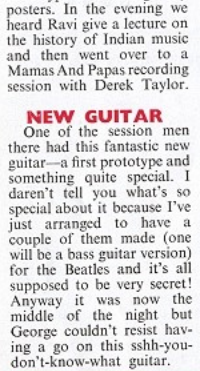





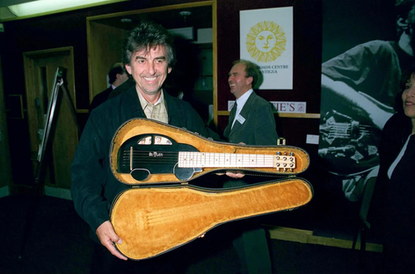
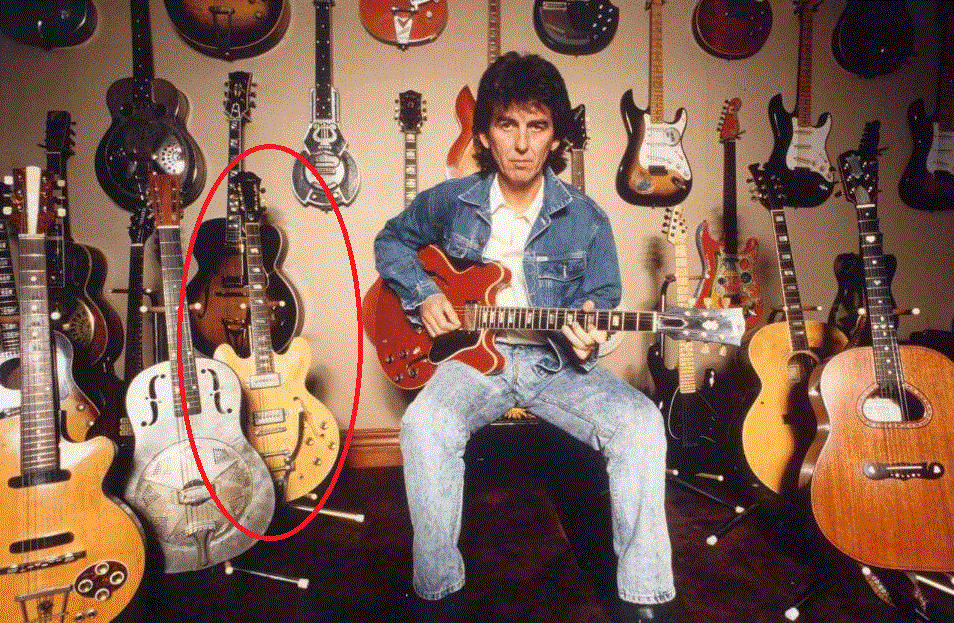



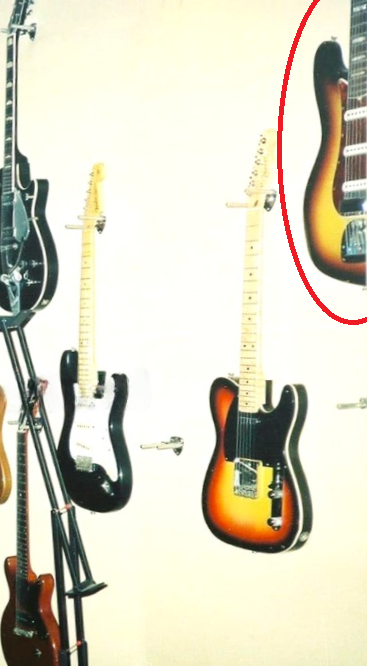


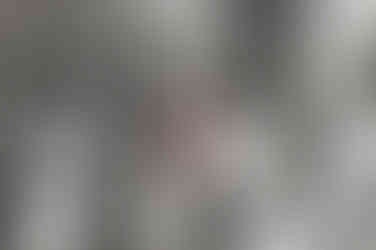






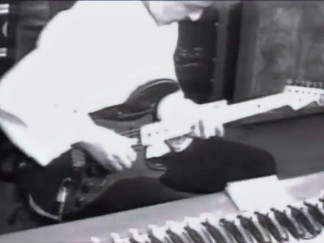
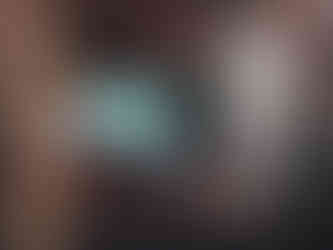














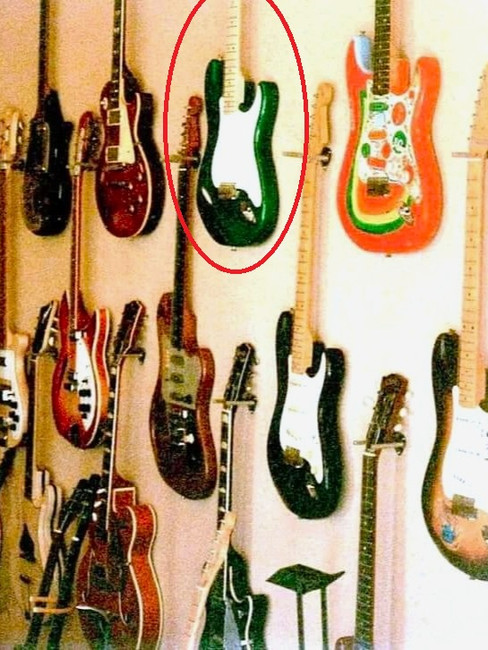

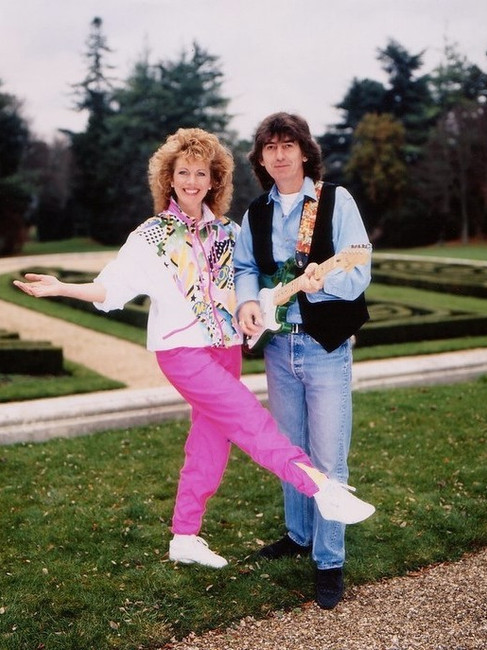







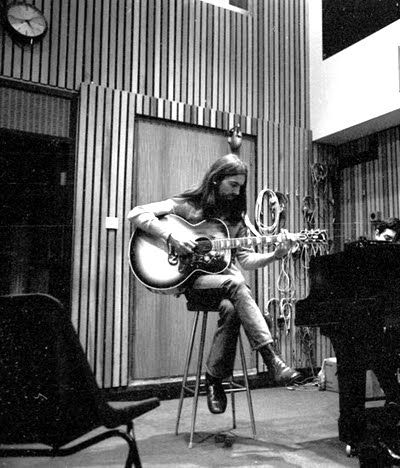



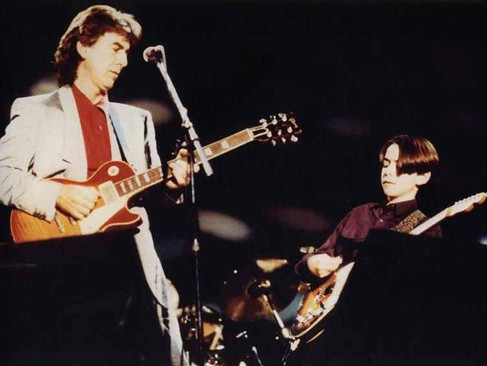





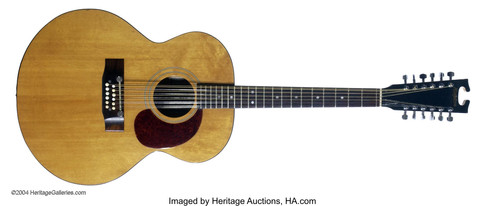



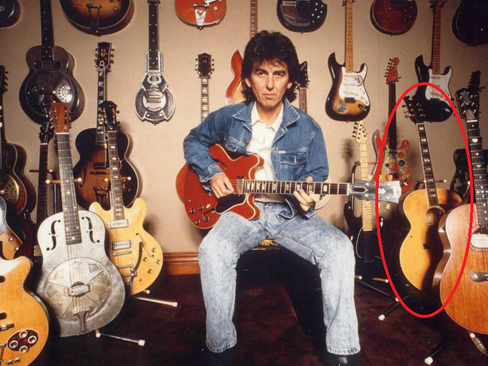




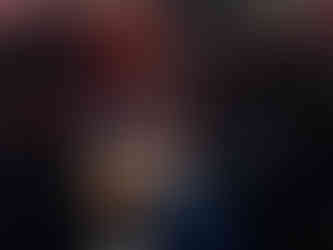









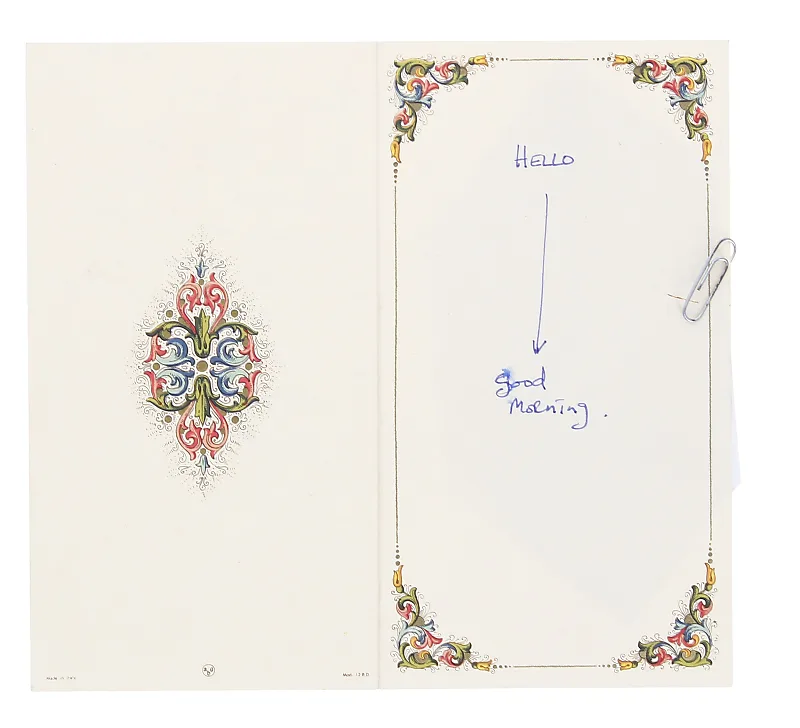
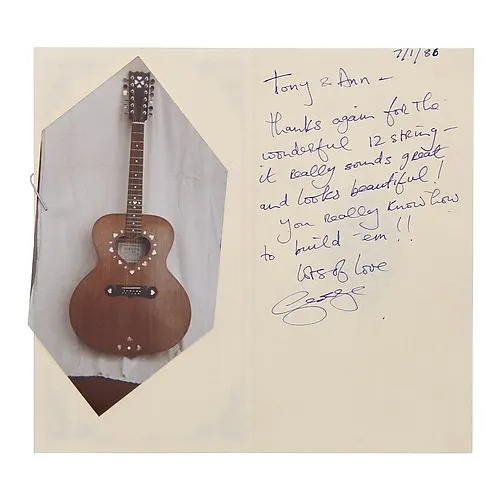



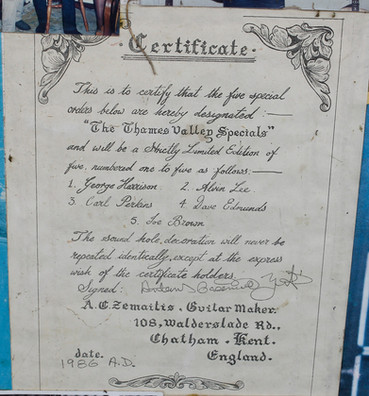



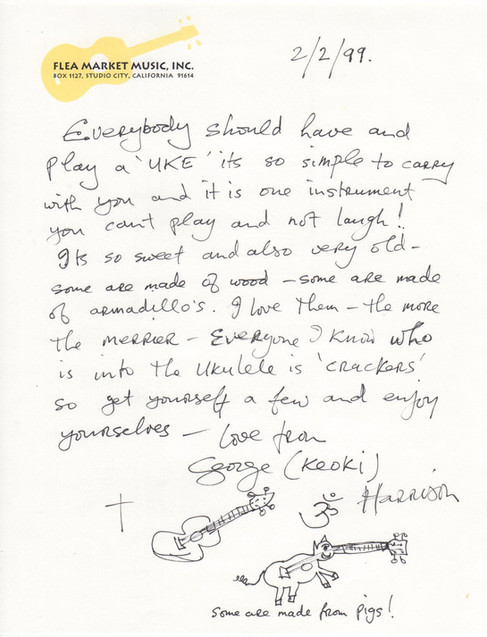



Comments